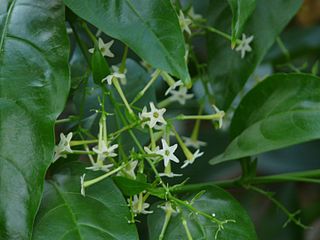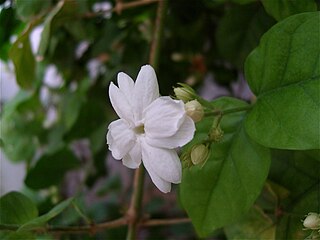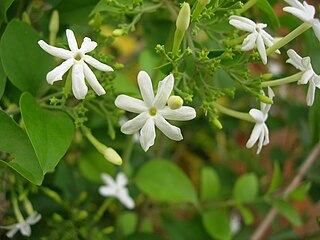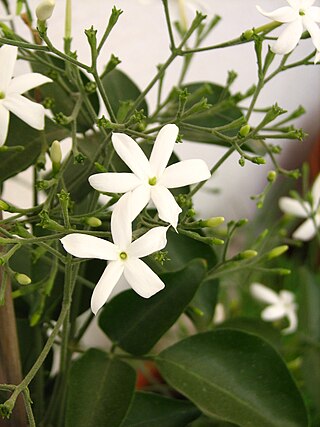
Jasmine is a genus of shrubs and vines in the olive family of Oleaceae. It contains around 200 species native to tropical and warm temperate regions of Eurasia, Africa, and Oceania. Jasmines are widely cultivated for the characteristic fragrance of their flowers.

Jasmine tea is tea scented with the aroma of jasmine blossoms. Typically, jasmine tea has green tea as the tea base; however, white tea and black tea are also used. The resulting flavour of jasmine tea is subtly sweet and highly fragrant. It is the most famous scented tea in China.

Cestrum nocturnum, the lady of the night, night-blooming jasmine, night-blooming jessamine, night-scented jessamine, night-scented cestrum or poisonberry, is a species of plant in the potato family Solanaceae. It is native to the West Indies, but naturalized in South Asia.

Jasminum sambac is a species of jasmine with a native range from Bhutan to India It is cultivated in many places, especially West Asia, South Asia and Southeast Asia. It is naturalised in many scattered locales: Mauritius, Madagascar, the Maldives, Christmas Island, Chiapas, Central America, southern Florida, the Bahamas, Cuba, Hispaniola, Jamaica, Puerto Rico, and the Lesser Antilles.

Jasminum polyanthum, the many-flowered jasmine, pink jasmine, or white jasmine, is a species of flowering plant in the olive family Oleaceae, native to China and Myanmar. A strong evergreen twining climber, it is especially noted for its abundant, highly fragrant pink to white flowers.

Mandevilla laxa, commonly known as Chilean jasmine, is an ornamental plant in the genus Mandevilla of family Apocynaceae.

Jasminium dichotomum, the Gold Coast jasmine, is a species of jasmine, in the family Oleaceae. It is an evergreen climber which grows as a rambling shrub or woody vine. The flowers are quite fragrant and open at night, coloured pink when budding then white; these appear at the leaf axils in cluster. It blooms year round. The leaves are opposite. The fleshy fruit is small.

Jasminum grandiflorum, also known variously as the Spanish jasmine, Royal jasmine, Catalan jasmine, Sicilian jasmine, is a species of jasmine native to South Asia, the Arabian peninsula, East and Northeast Africa and the Yunnan and Sichuan regions of China. The species is widely cultivated and is reportedly naturalized in Guinea, the Maldive Islands, Mauritius, Réunion, Java, the Cook Islands, Chiapas, Central America, and the Caribbean. It is closely related to, and sometimes treated as merely a form of, Jasminum officinale.

Jasmine is considered the queen of flowers and is called the "Belle of India" or the "Queen of fragrance" as it is exquisitely scented to soothe and refresh. In different parts of India it is called by different names—Mogra, Motia, Chameli, Malli puvvu, Jaati, Mulla, Mallige, Juhi, Mogra or Moonlight in the grove. It is reported that there are 300 varieties of jasmine. It is also stated that jasmine crossed the seas—from Asia to Europe, landing first along the Mediterranean Sea, conquering Greece and Turkey, reaching Western Europe through Spain, then France and Italy and finally landing in England in the latter part of the 17th century..

Jasminum officinale, known as the common jasmine or simply jasmine, is a species of flowering plant in the olive family Oleaceae. It is native to the Caucasus and parts of Asia, also widely naturalized.

Jasminum auriculatum is a species of jasmine, in the family Oleaceae. It is found in India, Nepal, Sri Lanka, Bhutan and the Andaman Islands. Due to essential oil contained in the flowers, it is cultivated commercially in India and Thailand. It is used for decorative purposes and festivals in India.

Jasminium abyssinicum is a species of jasmine, in the family Oleaceae.

Jasminum multiflorum, commonly known as star jasmine, is a species of jasmine in the family Oleaceae.

Jasminum angulare, the wild jasmine or angular jasmine, is a species of flowering plant in the family Oleaceae that is indigenous to South Africa.

Chrysojasminum humile, the Italian jasmine or yellow jasmine, is a species of flowering plant in the family Oleaceae, native to Afghanistan, Tajikistan, Pakistan, Nepal, Burma (Myanmar), the Himalayas and south west China. The species is widely cultivated and reportedly naturalized in Greece, Sicily and the former Yugoslavia.

Jasminum tortuosum is a species of jasmine native to South Africa. It is generally found twining high into the trees of forests in southwestern part of Cape Province, but also may scramble where there is little vertical space. It has angular branches off its main stem, and its flowers usually have five white petals each. The specific epithet (tortuosum) is from Latin, describing something that is winding or very twisted.

Jasminum azoricum, the lemon-scented jasmine, is a species of flowering plant in the olive family. It is an evergreen twining vine native to the Portuguese island of Madeira. The compound leaves consist of 3 bright green leaflets. The fragrant white star-shaped flowers appear in panicles from the leaf axils in summer, evolving from deep pink buds.

Jasminum malabaricum, the Malabar jasmine or wild jasmine, is a species of flowering plant in the family Oleaceae, native to southern parts of India, and Sri Lanka.

Jasminum angustifolium, the wild jasmine, is a species of jasmine native to Sri Lanka and India, including the Andaman Islands. It is a climbing shrub with a smooth stem and minutely pubescent branchlets. It grows up to 6 m (20 ft) tall. Leaves are dark green and opposite in arrangement. The flowers are approximately 25 mm (1 in) in diameter, and resemble a star with seven or eight narrow petals, flowering between June and August.

Jasminum elongatum is a species of flowering plant in the family Oleaceae.




















